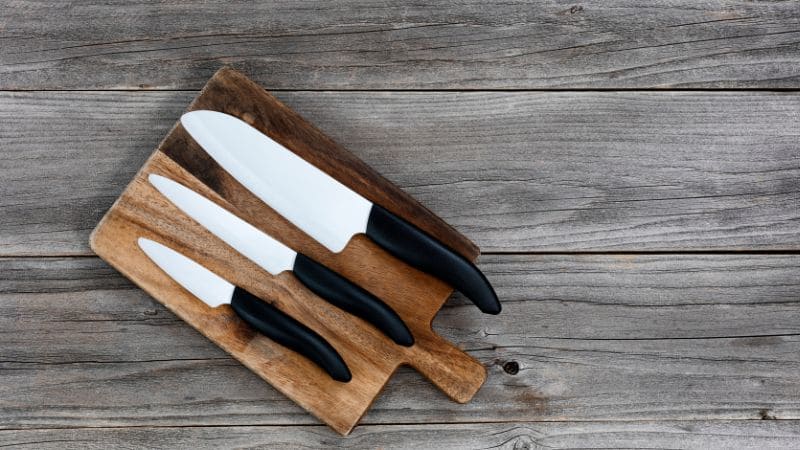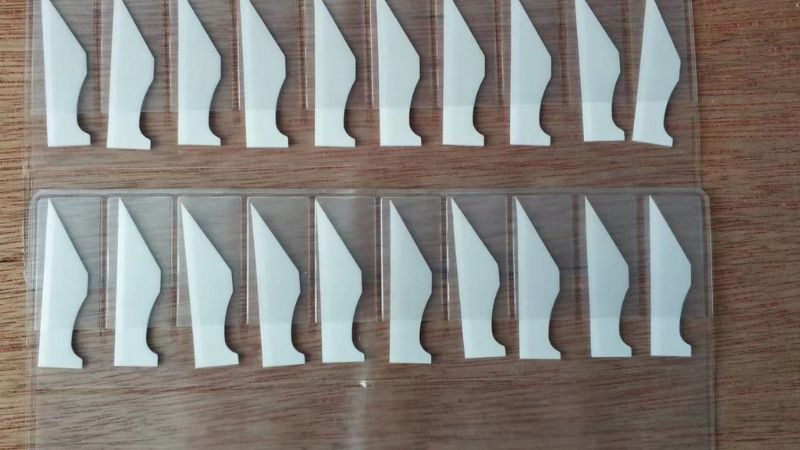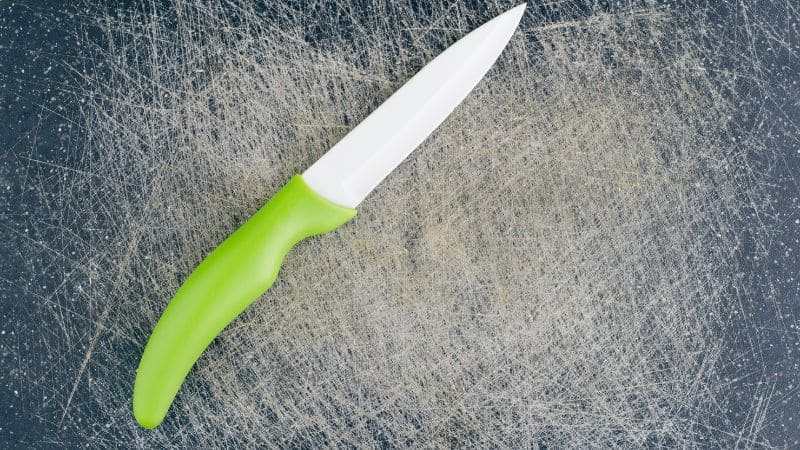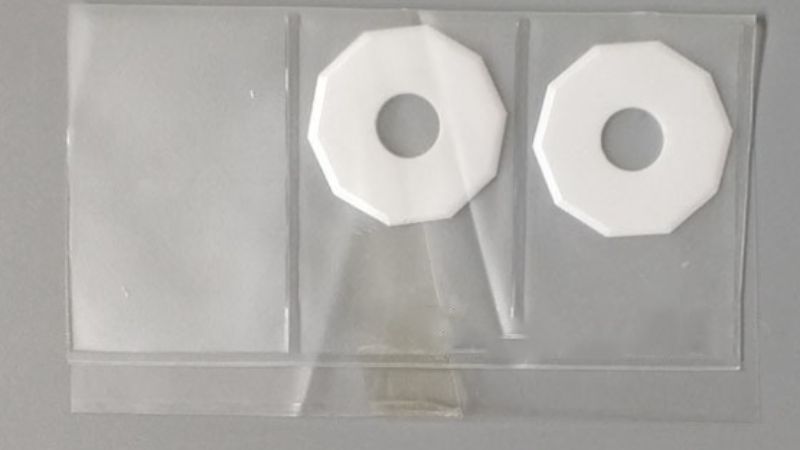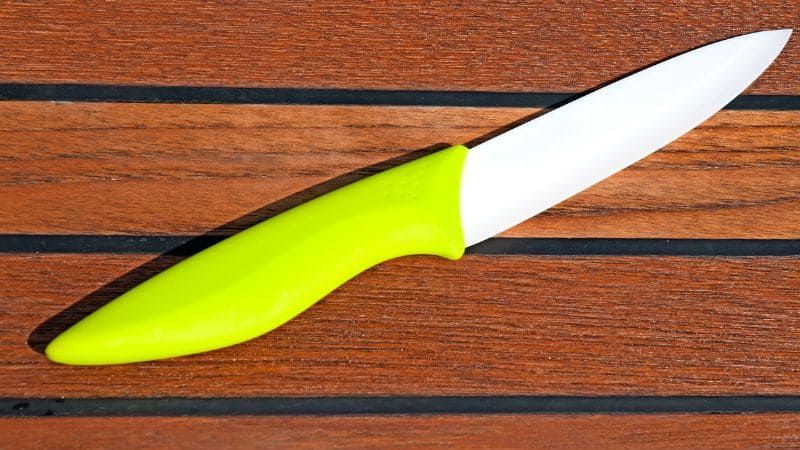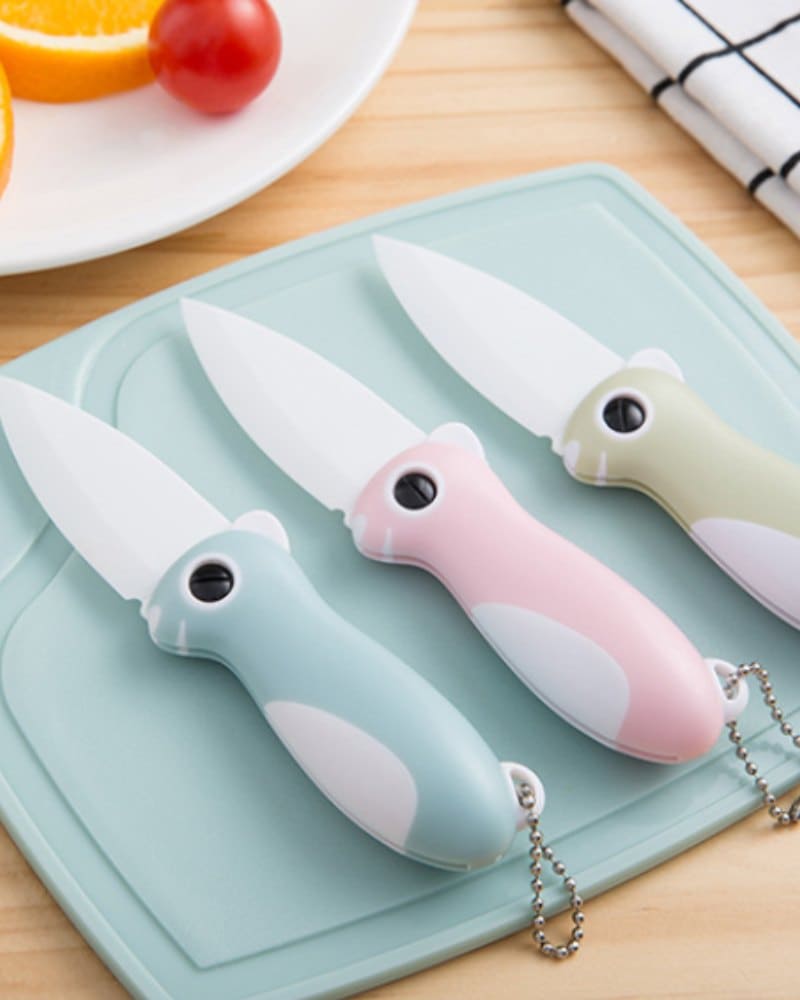Table of Contents
I’ve always been fascinated by how sharp and reliable ceramic blades are. They seem to outperform steel in so many ways, especially when it comes to edge retention. But let’s be honest—no blade lasts forever. A common question that comes up is: do ceramic blades get dull over time?
Yes, ceramic blades do get dull over time, but they stay sharper significantly longer than traditional steel blades. Factors like improper use, cutting hard materials, or accidental drops can cause them to dull or chip. With proper care, they can retain their edge for years.
I’ll walk you through the factors that affect their sharpness and how to make sure they stay in top condition for as long as possible.
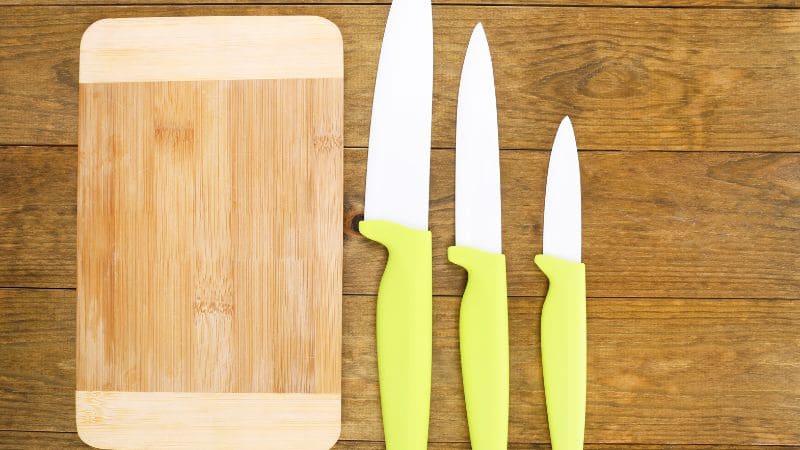
What Are Ceramic Blades?
I was shocked at how alien ceramic blades were compared to the traditional steel knives I had experienced. These blades consist mostly of zirconium oxide (zirconia), a super-hard and… rust-resistant material. Because of this unique material, ceramic blades have a leg up on traditional metal blades.
Composition of Ceramic Blades
Ceramic blades aren’t actually ceramic but are instead made from zirconium oxide, a material that’s exposed to extreme heat when making these knives. This converts the material into a super hard, dense blade that can stay sharper for far longer compared to plain steel. The sintering process renders ceramic blades almost as hard as diamonds, measuring in at about 8.5 on the Mohs scale of hardness.
Key properties of ceramic blades include:
- Corrosion Resistance – The ceramic can’t rust or corrode, despite being exposed to water or acidic foods.
- Non-Magnetic – Steel is magnetic but ceramic blades are non-magnetic and do not conduct electricity.
- Lightweight – They are much lighter than steel ones and minimize wrist fatigue during long working hours.
How They Compare to Metal Blades
At first sight, there may not be much on a ceramic blade to distinguish it from a traditional metal one, except for in practice. Here’s how they compare:
| Feature | Ceramic Blades | Metal Blades |
|---|---|---|
| Sharpness Retention | Holds an edge up to 10x longer | Requires frequent sharpening |
| Weight | Lightweight | Heavier |
| Corrosion Resistance | Fully resistant | Susceptible to rust |
| Flexibility | Brittle and inflexible | Can bend slightly without breaking |
| Suitability for Hard Materials | Not ideal | Suitable for hard materials |
Do Ceramic Blades Get Dull Over Time?
One of the biggest selling points for ceramic blades is their ability to hold an edge far longer than steel blades. But yes, they do get dull—just not as quickly. The longevity of their sharpness depends heavily on how they’re used and maintained.
Ceramic blades owe their extended sharpness to the hardness of zirconium oxide. This material resists wear better than steel, allowing ceramic blades to retain their cutting edge for months or even years without needing sharpening. However, the very hardness that makes them durable also makes them brittle. A small mistake, like cutting into a hard surface, can cause chipping or micro-fractures along the edge.
In everyday use, ceramic blades are ideal for slicing soft foods—like fruits, vegetables, and boneless meats. But they’re not built to handle bones, frozen foods, or anything requiring force. Improper use in these situations speeds up dulling or leads to breakage.
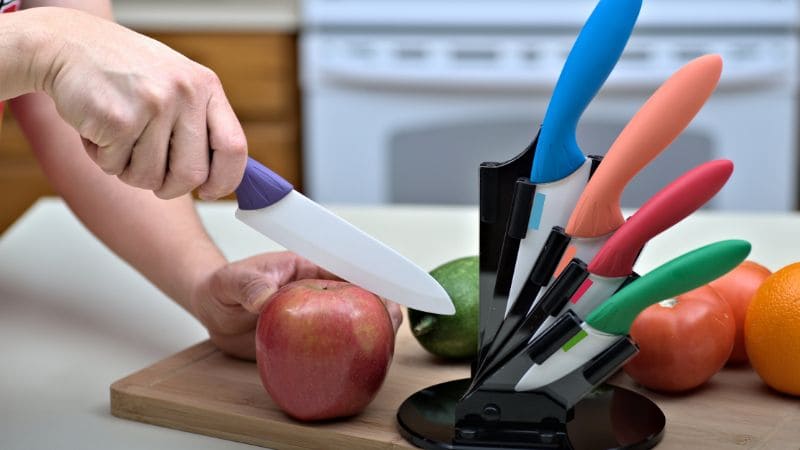
Person using a ceramic knife with a purple handle to cut an apple, with a colorful knife set in a black stand and fresh fruits on a wooden cutting board
How Long Do Ceramic Blades Stay Sharp?
On average, ceramic blades stay sharp 10 times longer than standard steel blades. For a kitchen knife, this means you could go anywhere from 6 months to 3 years without needing to sharpen the blade, depending on frequency of use and how carefully it is handled.
| Blade Type | Average Sharpness Duration | Common Usage |
|---|---|---|
| Ceramic Blades | 6 months to 3 years | Slicing fruits, vegetables, meats |
| High-Carbon Steel Blades | 2 to 6 months | General kitchen use |
| Stainless Steel Blades | 1 to 3 months | All-purpose cutting |
The prolonged sharpness of ceramic blades reduces the need for constant maintenance, but this benefit comes with a trade-off. Once ceramic blades become dull, sharpening them can be more complicated than sharpening a steel blade.
Factors Contributing to Dullness
Even though ceramic blades maintain their edge for a long time, several factors can lead to premature dulling:
- Cutting Hard or Frozen Foods – Ceramic blades are not designed to cut through hard materials like bone or frozen meat. Doing so can cause immediate chipping or fractures along the edge.
- Impact Damage – Dropping a ceramic knife onto a hard surface can cause the blade to chip or snap, reducing sharpness and usability.
- Improper Storage – Storing ceramic blades loosely in drawers or with other utensils can lead to accidental chips and dulling.
- Use on Hard Cutting Boards – Cutting on glass, stone, or metal surfaces can rapidly wear down the edge. Soft wooden or plastic cutting boards are best for ceramic knives.
Pro Tip: Always use a soft cutting surface and store ceramic blades in a protective sheath to extend their lifespan.
Why Ceramic Blades Become Dull?
While ceramic blades may appear to be virtually indestructible when first used, their extraordinary strength does have its limits. Ceramic knives won’t corrode like steel, but they can be brittle and chip, and are more susceptible to certain kinds of wear and damage. Understanding what causes the surface to dull can help you take preventative measures to help them last longer.
Improper Use
Using a ceramic knife for a job it’s not intended for is one of the quickest ways to dull or harm the blade. Ceramic knives are great for slice soft foods but not good for cutting bones, frozen items, or hard materials. Improper usage of them often results in edge chipping or full fractures along the blade.
- Avoid: Bones, frozen meat, crusty bread, and hard cheeses.
- Best Use: Soft vegetables, fruits, and boneless proteins.
Fact: Per research, improper use leads to around 60% breakage of ceramic knives stated by users.
Cutting Hard Materials
Cutting dense or hard materials may also contribute to increased wear, even when used under normal conditions. Ceramic blades do stay sharper for longer than steel, but are more brittle, meaning they’re more likely to chip when used against harder surfaces.
- Cutting hard materials like pumpkin shells, root vegetables (such as sweet potatoes) and frozen fruits will dull the cutting edge.
- Small cracks can appear at the edge of the blade, dulling it over time.
Tip: Avoid wooden or plastic cutting boards that are hard to chop the blade.
Dropping or Impact Damage
Ceramic blades are highly brittle when subjected to an impact. Fall onto a hard surface will chip the knife instantly or even break the blade. Even if you can’t see the damage, dropping a ceramic knife usually results in micro-cracks that will cause the edge to dull faster
| Risk of Damage | Metal Blades | Ceramic Blades |
|---|---|---|
| Dropping from countertop height | Minor denting | High chance of chipping or shattering |
| Cutting into bone | Dulls gradually | Immediate risk of fracture |
| Cutting frozen food | Dulls but can be resharpened | Likely to chip |
| Storage with loose utensils | Scratches | Chipping along the edge |
Tip: Always store ceramic knives in a protective sheath or on a magnetic strip so they don’t accidentally collide with other tools.
Poor Storage Practices
Throwing ceramic knives in a drawer or in any together with other utensils is a certain recipe for disaster. The blade’s edge is susceptible to impact with harder material, resulting in little chips that compound over time.
- Proper storage: Use blade guards, knife blocks, or dedicated drawer inserts.
- Do not stuff ceramic knives in utensil drawers without protection
Fact: If you don’t protect the blade of ceramic knives when storing them, you can shorten the lifespan of one by up to 30% as the edge will get worn out unnecessarily.
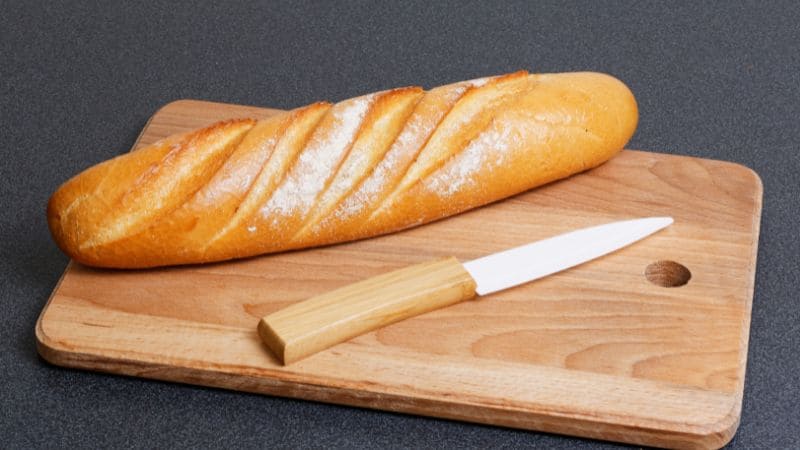
While ceramic blades retain their sharpness for long periods, no blade stays razor-sharp indefinitely. Understanding the signs of dullness can save you time, prevent accidents, and make sure your tools work optimally. Here are the signs that a ceramic knife is dulled the most:
Decreased Cutting Efficiency
The first and most glaring indicator is increased resistance when you slice. One of the most revered aspects of ceramic blades are their smooth, easy slicing. If you notice that you have to apply more force to get through a piece of fruit or vegetable, it’s a sign that the blade is dulling.
- How to Test: Walk a knife through a ripe tomato. A new, sharp ceramic blade will slice right through; while an old, dull blade may slip and crush the flesh..
Jagged or Rough Cuts
Once-sharp ceramic blades become so dull they can no longer pull off the clean, fine cuts they did before. If you see ragged edges or uneven slices, the blade is starting to dull. This can be particularly troublesome when cutting delicate ingredients such as herbs or softer fruits.
- Visual Clue: Look at the texture of the cut. Clean cuts show the blade is sharp; ragged or torn edges indicate dullness.
Visual Chips or Imperfections
Ceramic blades don’t dull like steel. Whereas the latter wear down slowly, they chip on the edge. These minute chips, typically undetectable without a microscope, influence cutting performance
- Inspection Tip: Place the blade under a bright light and look at it at all angles. Small nicks or rough spots along the edge are signs that the blade is beginning to chip.
| Sign of Dullness | Description | Severity |
|---|---|---|
| Increased Cutting Resistance | Requires more force for slicing | Mild |
| Jagged or Uneven Cuts | Produces rough, irregular slices | Moderate |
| Visible Chips or Nicks | Small chips along the blade’s edge | Severe – Blade may need repair |
Crushing Instead of Slicing
When dull, ceramic blades tend to crush soft foods instead of slicing. This is especially true of bread, tomatoes or soft-skinned fruits. Instead of clean slices, it squishes your produce instead of slicing it.
- Example: A blunt blade may tear lettuce or smash a sandwich, rather than cut cleanly.
Noise During Cutting
A razor-sharp ceramic knife moves quietly. If you hear grinding or scraping sounds when cutting, it might mean that the edge is uneven or chipped. This sound has been found to be a sign that the blade is dragging along the surface causing more unnecessary damage.
Can Ceramic Blades Be Sharpened?
Sharpening ceramic blades can feel like a challenge, especially if you’re used to working with steel knives. Unlike metal, ceramic is harder and more brittle, requiring specialized tools and techniques to restore the blade’s edge without causing further damage. Let me break down how it’s done.
Methods for Sharpening Ceramic Blades
- Diamond Sharpening Stones – Since ceramic is extremely hard, traditional sharpening stones won’t cut it—literally. Diamond sharpening stones are the best option because diamonds rank higher on the Mohs scale than zirconium oxide. The process involves:
- Placing the stone on a flat surface.
- Holding the blade at a 20-degree angle.
- Gently drawing the blade across the stone in one direction (never saw back and forth).
- Electric Diamond Sharpeners – For those who prefer convenience, electric sharpeners designed for ceramic knives are an excellent option. These machines use diamond-coated wheels to carefully grind down the blade.
- Simply insert the blade and slowly pull it through the slot.
- Diamond Files – If you’re dealing with small chips or imperfections, a handheld diamond file can help smooth out the edge. This method is slower but gives you more control over the sharpening process.
Tools Required for Sharpening Ceramic Blades
| Tool | Purpose | Ease of Use |
|---|---|---|
| Diamond Sharpening Stone | Manual sharpening and edge maintenance | Moderate |
| Electric Diamond Knife Sharpener | Automatic sharpening for consistent results | Easy |
| Diamond File | Precision sharpening for small chips | Moderate to Difficult |
Professional Sharpening Services
If you’re not comfortable sharpening ceramic blades yourself, many manufacturers and third-party services offer professional sharpening. Companies like Kyocera provide mail-in services to restore ceramic knives to near-factory sharpness. While this may cost more than sharpening steel knives at home, it extends the lifespan of your ceramic tools.
Pro Tip: If the blade is severely chipped, professional services are often the best route to avoid making the problem worse.
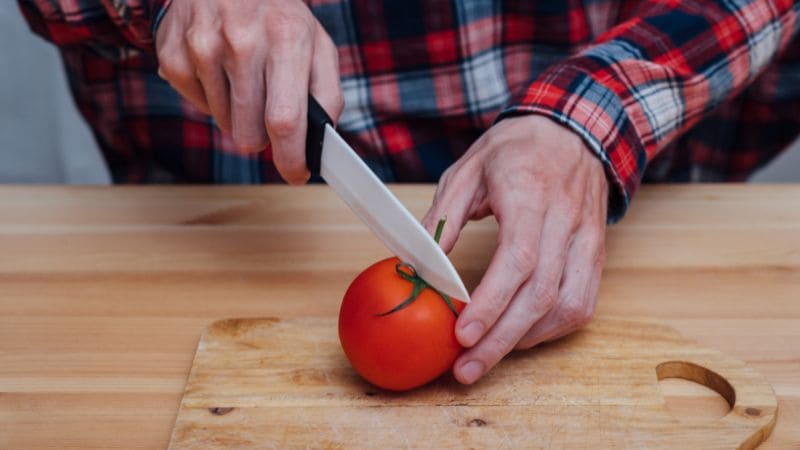
How often do ceramic blades need sharpening?
Ceramic blades can last up to 3 years with regular use. If you use them every day, however, you may need to sharpen them every 12 to 18 months, depending on how well you treat them.
Is there a need to sharpen ceramic knives?
No. Standard knife sharpeners are designed to sharpen steel and will not sharpen ceramic blades effectively. You will require a diamond-coated sharpener or stone, which is specifically designed for ceramic knives.
Are ceramic blades more fragile than steel blades?
Yes. Ceramic blades, although maintaining sharpness longer, are brittle and can chip or break when dropped or used carelessly. Steel blades are more durable but need to be sharpened more often.
What should I avoid cutting with a ceramic blade?
Do not cut bones, frozen foods or hard crusts. Ceramic blades are ideal for slicing soft fruits and vegetables, as well as boneless meats, but may chip when used on harder materials.
Can ceramic blades rust or corrode?
No. Ceramic is inherently rust-resistant and will not rust, making it ideal for the kitchen where knives encounter water and acidic foods on a regular basis.
Do ceramic blades dull easily? How can I avoid that?
Use a forgiving cutting surface (wood or plastic), avoid twisting the blade on impact, and store the knife in a protective sheath or knife block so the blade doesn’t come into contact with other utensils.
Conclusion
Ceramic blades are a fantastic choice for those seeking long-lasting sharpness and rust resistance. While they do require special care and sharpening techniques, their performance and durability make them invaluable kitchen tools. Proper use and regular maintenance will ensure they stay sharp for years to come.
